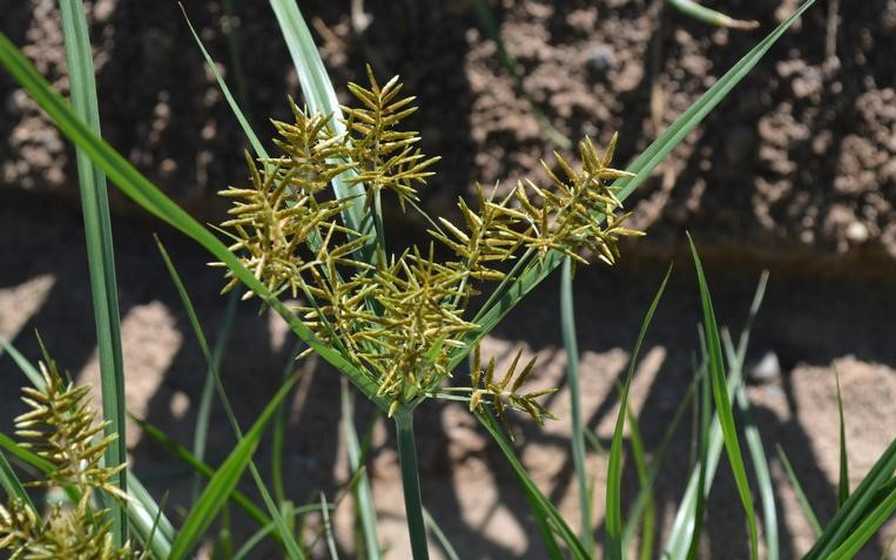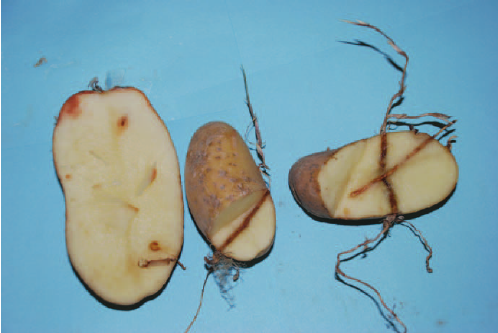Yellow Nutsedge
What is yellow nutsedge?
Yellow nutsedge (Cyperus esculentus) is a highly invasive perennial plant that can act as a weed in agricultural fields. There is currently one confirmed sighting of yellow nutsedge on PEI. It was originally found on a residential property, where it spread to a neighboring agricultural field. Yellow nutsedge can spread via rhizomes and tubers; it is less likely to spread by seed. The tubers have brown stripes and are similar in size to a hazelnut. It is suspected that they were introduced from Southwest Asia to Canada as a crop called ‘tiger nuts’.
How to identify yellow nutsedge?
Yellow nutsedge tends to grow in patches and is low-growing1 (can grow up to 80 cm in height) with narrow, flat, shiny leaves like a grass that come out of the base of the plant. Nutsedge may be confused with grass, however sedges have a distinct triangular stem. The plant blooms mid-summer and has yellow-brown, spikey flowers (Figure 1).

Figure 1. Flower of yellow nutsedge. Source: Photo by Howard F Schwartz of Colorado State University 1
What are the impacts of yellow nutsedge?
Yellow nutsedge was ranked the fourth most troublesome weed among all broadleaf crops, fruits and vegetables in the United States and Canada in 20222. It competes with other plants, causing yield reductions in crops commonly growing on PEI such as corn, soybeans, and potatoes. Crops that do not produce a full canopy (vegetables, root crops) are particularly vulnerable. Without competition between plants and between rows, the weed spreads rapidly and densely. One tuber can produce thousands more in a single season. In potatoes, yellow nutsedge roots can grow through the potato tuber, rendering them unmarketable1 (Figure 2).

Figure 2. Yellow nutsedge roots growing through potato tubers. Photo: Dr. Joel Felix, Oregon State University1
Yellow nutsedge spreads via rhizomes and tubers so, in an agricultural setting, it is easily distributed via contaminated soil on farm equipment within a field, and from field to field. It could also be moved via soil in nursery stock, packaged soil or amendments, transportation during harvest, or in construction materials (soil, gravel, compost).
Prevention and control of yellow nutsedge
Practice integrated weed management to reduce the risk of introducing yellow nutsedge to your farm. Soil on equipment moved from field to field is the most common way that yellow nutsedge spreads. Clean your equipment between fields to remove soil. If yellow nutsedge is found in a field, work that field last and work from the least contaminated area to the most.
Crop losses due to yellow nutsedge are heavier under irrigation and high nitrogen3. Only irrigate crops when necessary and practice the 4 R’s of nutrient management (right source, right rate, right time, right place). By using the proper amount of fertilizer near the seed row of the crop, you’ll make fertilizer more accessible to the crop and less accessible to weeds.
Herbicides effective for control of yellow nutsedge include halosulfuron (Permit), s-metalachlor (Dual II Magnum, Komodo), and dimethenamid-P (Frontier Max)3. This is not a comprehensible list and is only provided as a reference. Always read the product label; in case of disagreement between this list and the label, the label shall be considered correct. Please visit the Health Canada Pesticide Label Search (link is external)for the most up to date labels.
The PEI Invasive Species Council, with funding through the Sustainable Canadian Agricultural Partnership, is testing options for the management of yellow nutsedge on PEI. Data will be provided when available.
How can I report a sighting?
If you find a plant that you suspect is yellow nutsedge, do not remove the plant and report as early as possible. You can contact the PEI Invasive Species Council (link is external) or contact the Agri-Environmental Specialist at the PEI Department of Agriculture to report the plant.
Additional information:
NorthEast IPM (link is external)
PEI Invasive Species Council - Yellow Nutsedge
Contact:
PEI Invasive Species Council
peiinvasives@gmail.com (link sends e-mail)
or
PEI Department of Agriculture
Agri-Environmental Specialist
Shauna Barry
Tel: (902) 314-0388
slbarry@gov.pe.ca (link sends e-mail)
References
1 Wohleb, Carrie Huffman. “What You Can Do To Protect Your Potato Crop from Yellow Nutsedge (link is external)”. Growing Produce, 4 October, 2023, . Accessed June 27, 2024.
2 Van Wychen, Lee. “2022 Survey of the most common and troublesome weeds in broadleaf crops, fruits & vegetables in the United States and Canada (link is external)”. Weed Science Society of America, 2022.
3 Ransom, Corey V., Charles A. Rice, and Clinton C. Shock. “Yellow Nutsedge (Cyperus Esculentus) Growth and Reproduction in Response to Nitrogen and Irrigation (link is external).” Weed Science vol. 57, no. 1, February 2009, pp. 21–25.
4 OMAFRA. “Guide to weed control - field crops (link is external)”. Publication 75A. Ontario Ministry of Agriculture, Food and Rural Affairs, 2021, Toronto, ON.